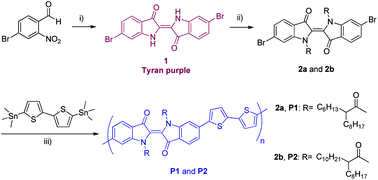Synthesis and properties of indigo based donor–acceptor conjugated polymers†
Abstract
Indigo is for the first time used as a building block to construct polymer semiconductors for organic thin film transistors (OTFTs). Two donor–acceptor polymers using indigo as the acceptor and bithiophene as the donor are synthesized via Stille coupling polymerization. Two types of acyl groups, 2-hexldecanoyl (for polymer P1) and 2-octyldodecanoyl (for polymer P2), are utilized as solubilizing side chains. These polymers possess very deep highest-occupied molecular orbital (HOMO) and lowest unoccupied molecular orbital (LUMO) energy levels, due to the strong electron accepting capability of the indigo moiety. In OTFT devices, characteristic n-type semiconductor performance with electron mobility of up to ∼10−3 cm2 V−1 s−1 is observed.


 Please wait while we load your content...
Please wait while we load your content...